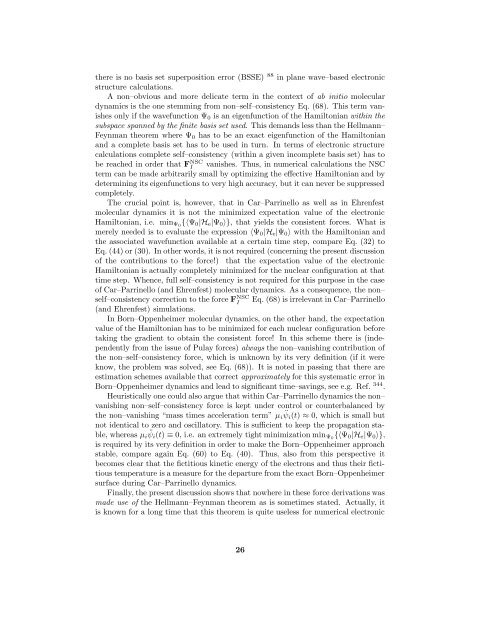Ab initio molecular dynamics: Theory and Implementation
Ab initio molecular dynamics: Theory and Implementation
Ab initio molecular dynamics: Theory and Implementation
- No tags were found...
Create successful ePaper yourself
Turn your PDF publications into a flip-book with our unique Google optimized e-Paper software.
there is no basis set superposition error (BSSE) 88 in plane wave–based electronicstructure calculations.A non–obvious <strong>and</strong> more delicate term in the context of ab <strong>initio</strong> <strong>molecular</strong><strong>dynamics</strong> is the one stemming from non–self–consistency Eq. (68). This term vanishesonly if the wavefunction Ψ 0 is an eigenfunction of the Hamiltonian within thesubspace spanned by the finite basis set used. This dem<strong>and</strong>s less than the Hellmann–Feynman theorem where Ψ 0 has to be an exact eigenfunction of the Hamiltonian<strong>and</strong> a complete basis set has to be used in turn. In terms of electronic structurecalculations complete self–consistency (within a given incomplete basis set) has tobe reached in order that F NSCI vanishes. Thus, in numerical calculations the NSCterm can be made arbitrarily small by optimizing the effective Hamiltonian <strong>and</strong> bydetermining its eigenfunctions to very high accuracy, but it can never be suppressedcompletely.The crucial point is, however, that in Car–Parrinello as well as in Ehrenfest<strong>molecular</strong> <strong>dynamics</strong> it is not the minimized expectation value of the electronicHamiltonian, i.e. min Ψ0 {〈Ψ 0 |H e |Ψ 0 〉}, that yields the consistent forces. What ismerely needed is to evaluate the expression 〈Ψ 0 |H e |Ψ 0 〉 with the Hamiltonian <strong>and</strong>the associated wavefunction available at a certain time step, compare Eq. (32) toEq. (44) or (30). In other words, it is not required (concerning the present discussionof the contributions to the force!) that the expectation value of the electronicHamiltonian is actually completely minimized for the nuclear configuration at thattime step. Whence, full self–consistency is not required for this purpose in the caseof Car–Parrinello (<strong>and</strong> Ehrenfest) <strong>molecular</strong> <strong>dynamics</strong>. As a consequence, the non–self–consistency correction to the force F NSCIEq. (68) is irrelevant in Car–Parrinello(<strong>and</strong> Ehrenfest) simulations.In Born–Oppenheimer <strong>molecular</strong> <strong>dynamics</strong>, on the other h<strong>and</strong>, the expectationvalue of the Hamiltonian has to be minimized for each nuclear configuration beforetaking the gradient to obtain the consistent force! In this scheme there is (independentlyfrom the issue of Pulay forces) always the non–vanishing contribution ofthe non–self–consistency force, which is unknown by its very def<strong>initio</strong>n (if it wereknow, the problem was solved, see Eq. (68)). It is noted in passing that there areestimation schemes available that correct approximately for this systematic error inBorn–Oppenheimer <strong>dynamics</strong> <strong>and</strong> lead to significant time–savings, see e.g. Ref. 344 .Heuristically one could also argue that within Car–Parrinello <strong>dynamics</strong> the non–vanishing non–self–consistency force is kept under control or counterbalanced bythe non–vanishing “mass times acceleration term” µ i ¨ψi (t) ≈ 0, which is small butnot identical to zero <strong>and</strong> oscillatory. This is sufficient to keep the propagation stable,whereas µ i ¨ψi (t) ≡ 0, i.e. an extremely tight minimization min Ψ0 {〈Ψ 0 |H e |Ψ 0 〉},is required by its very def<strong>initio</strong>n in order to make the Born–Oppenheimer approachstable, compare again Eq. (60) to Eq. (40). Thus, also from this perspective itbecomes clear that the fictitious kinetic energy of the electrons <strong>and</strong> thus their fictitioustemperature is a measure for the departure from the exact Born–Oppenheimersurface during Car–Parrinello <strong>dynamics</strong>.Finally, the present discussion shows that nowhere in these force derivations wasmade use of the Hellmann–Feynman theorem as is sometimes stated. Actually, itis known for a long time that this theorem is quite useless for numerical electronic26









